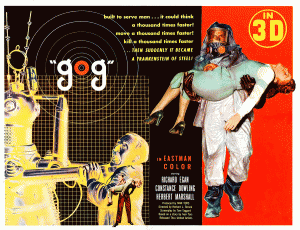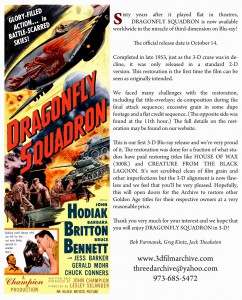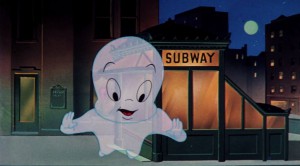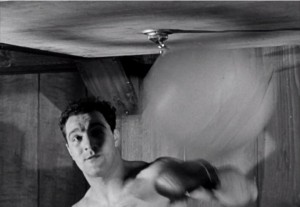3-D Television and the Stereoscopic Archive
Post by Nick Camfield, University of Nottingham
This post continues the ongoing “From Nottingham and Beyond” series, with contributions from faculty and alumni of the University of Nottingham’s Department of Culture, Film and Media. This week’s contributor, Nick Camfield, completed his PhD in the department in 2014.
In perhaps the most striking sequence in Bill Morrison’s Decasia: The State of Decay (2002), a boxer launches heavy cross-blows at a punching bag obscured by decomposing film stock. As the nitrate warps and bubbles, the boxer’s punches seem defiant. As Morrison recounted, “I wasn’t just looking for instances of decayed film, [but] instances where the image [was] fighting off the inexorability of its demise.”[1]
Nitrate film was highly combustible and subject to serious chemical deterioration, and Morrison did have opportunities to adulterate his decaying elements further. Decasia nevertheless serves as an anti-Bazinian statement on mortality and a powerful call for film preservation—an unending process of curatorship, working with nitrate and triacetate bases, and with analog and digital formats. As R. M. Hayes notes, 3-D filmmaking dates almost to cinema’s inception.[2] While preservation of the 2D cinematic archive is considered a valuable endeavor, the stereoscopic archive has received comparatively little attention. The mass production of 3-D televisions and home video players has opened spaces for 3-D film spectatorship and restoration, however, and for appropriations of older stereoscopic texts through expressions of nostalgia and subcultural capital.
As I argue in my PhD thesis, 3-D television emerged as a mass-produced technology as part of a cycle that crossed media platforms and bolstered development trends in each.[3] At the same time, discourses on safety and convenience and accusations of gimmickry informed 3-D television’s situation in the media marketplace.[4] Such complaints were rooted in longstanding claims about the unviability of 3-D media. If, as Keith Johnston maintains, 3-D has reached a “final moment,” in which historical discourses have arrested the technology’s potential,[5] one might observe that 3-D television’s fate was determined long before its introduction. Assertions that 3-D television has failed absolutely are widespread. Television reviewers stress that 3-D functionality is of little interest, yet they are obliged to discuss this aspect of performance. Satellite broadcasters have abandoned 3-D production, due to negligible viewing figures and to make room for ultra-high definition (UHD) platforms. A technology that manufacturers heralded as “revolutionary” has quickly become a sideshow attraction.
 Rejections of stereoscopic technology have emboldened 3-D media fans, however, and current aesthetic practices have further encouraged devotees. According to Barbara Klinger, 21st-century 3-D filmmakers have eschewed “pop-out” effects to preserve Hollywood’s invisible styling.[6] Keith Johnston likewise suggests that conservative aesthetic choices limited 3-D television’s appeal.[7] Filmmakers such as James Cameron have worked to distinguish 21st-century 3-D filmmaking from that of earlier periods. In breaking the fourth wall, the argument goes, 3-D “pop-out” disrupts narrative continuity. To address this difficulty, it is claimed, “pop-out” should be minimized and depth of field accentuated. Such assertions offer fans of older 3-D films something to rail against: namely, alleged corporate behemoths steamrolling their visceral pleasures. For aficionados, current aesthetic practices stand in contradistinction to a “golden age” of stereoscopic filmmaking slowly being revived on home video.
Rejections of stereoscopic technology have emboldened 3-D media fans, however, and current aesthetic practices have further encouraged devotees. According to Barbara Klinger, 21st-century 3-D filmmakers have eschewed “pop-out” effects to preserve Hollywood’s invisible styling.[6] Keith Johnston likewise suggests that conservative aesthetic choices limited 3-D television’s appeal.[7] Filmmakers such as James Cameron have worked to distinguish 21st-century 3-D filmmaking from that of earlier periods. In breaking the fourth wall, the argument goes, 3-D “pop-out” disrupts narrative continuity. To address this difficulty, it is claimed, “pop-out” should be minimized and depth of field accentuated. Such assertions offer fans of older 3-D films something to rail against: namely, alleged corporate behemoths steamrolling their visceral pleasures. For aficionados, current aesthetic practices stand in contradistinction to a “golden age” of stereoscopic filmmaking slowly being revived on home video.
 Though recent Hollywood blockbusters are well represented on 3-D Blu-ray, older titles have until very recently been neglected. Over the past two years, both conglomerate and independent Blu-ray distributors have issued dual-frame–format releases of older 3-D movies. Since none of these titles were re-released theatrically, home-video reissue represents the only opportunity to view them in anything approximating their cinematic form.[8] Moreover, without the advent of 3-D television, such restorations would not have been undertaken, likely abandoning many of these cultural artifacts to decay. In order of 3-D Blu-ray release, one can now (or shortly) access The Creature from the Black Lagoon (1954), Dial M for Murder (1954), Amityville 3-D (1983), House of Wax (1953), The Bubble (1966), Dragonfly Squadron (1954), Inferno 3-D (1953), Kiss Me Kate (1953), Comin’ at Ya! (1981, forthcoming), The Mask (1961, forthcoming), and Gog (1954, forthcoming). Nonetheless, this list represents a small fraction of historical 3-D productions with still retrievable negatives.
Though recent Hollywood blockbusters are well represented on 3-D Blu-ray, older titles have until very recently been neglected. Over the past two years, both conglomerate and independent Blu-ray distributors have issued dual-frame–format releases of older 3-D movies. Since none of these titles were re-released theatrically, home-video reissue represents the only opportunity to view them in anything approximating their cinematic form.[8] Moreover, without the advent of 3-D television, such restorations would not have been undertaken, likely abandoning many of these cultural artifacts to decay. In order of 3-D Blu-ray release, one can now (or shortly) access The Creature from the Black Lagoon (1954), Dial M for Murder (1954), Amityville 3-D (1983), House of Wax (1953), The Bubble (1966), Dragonfly Squadron (1954), Inferno 3-D (1953), Kiss Me Kate (1953), Comin’ at Ya! (1981, forthcoming), The Mask (1961, forthcoming), and Gog (1954, forthcoming). Nonetheless, this list represents a small fraction of historical 3-D productions with still retrievable negatives.
 Perhaps the most diligently restored stereoscopic release to date is 3-D Rarities, a collection of 22 shorts and novelties held by the 3-D Film Archive and distributed on Blu-ray by Flicker Alley. The films date from 1922 to 1962 and include documentary footage of New York City, anti–nuclear testing film Doom Town (1953), a Pennsylvania Railroad promotion, animated short The Adventures of Sam Space (1953), Casper the Friendly Ghost short Boo Moon (1954), and a Francis Ford Coppola–directed burlesque sequence from 1962.[9] Flicker Alley’s release prompted subcultural expression among enthusiasts, who dismiss recent Hollywood 3-D filmmaking in favor of a lost and unapologetically in-your-face aesthetic. Claims that Hollywood has domesticated 3-D allow fans of historical stereoscopic texts to position themselves in opposition to “mainstream” sensibilities and production techniques, as evidenced by user reviews of Flicker Alley’s release.
Perhaps the most diligently restored stereoscopic release to date is 3-D Rarities, a collection of 22 shorts and novelties held by the 3-D Film Archive and distributed on Blu-ray by Flicker Alley. The films date from 1922 to 1962 and include documentary footage of New York City, anti–nuclear testing film Doom Town (1953), a Pennsylvania Railroad promotion, animated short The Adventures of Sam Space (1953), Casper the Friendly Ghost short Boo Moon (1954), and a Francis Ford Coppola–directed burlesque sequence from 1962.[9] Flicker Alley’s release prompted subcultural expression among enthusiasts, who dismiss recent Hollywood 3-D filmmaking in favor of a lost and unapologetically in-your-face aesthetic. Claims that Hollywood has domesticated 3-D allow fans of historical stereoscopic texts to position themselves in opposition to “mainstream” sensibilities and production techniques, as evidenced by user reviews of Flicker Alley’s release.
Fans derive clear pleasures from an older stereoscopic aesthetic, while decrying 21st- century Hollywood practices. As one reviewer enthused, “This is the first real example of what 3-D was to me when I grew up. Short and to the pointy!” Others remarked that “Unlike modern 3-D films, vintage 3-D is incredibly strong and will push your 3-D television to its full potential”; “Don’t expect today’s Hollywood films to come close to the level of dimensional enjoyment you will experience here”; and “Contemporary 3-D movies just don’t take advantage of the medium the way these classics did.” Such observations pervade commentary on 3-D Rarities, along with calls for access to a wider catalog of historical 3-D texts. In the absence of such representation, there is comfort in the knowledge that a limited archive of stereoscopic titles is currently both rejuvenated and enjoyed.
[1] Flicker Alley’s Blu-ray 3-D Rarities includes similar training footage of Rocky Marciano, who, through use of negative parallax, seems to hit a punching bag through the screen plane. This footage has been carefully stored and digitally restored, unlike the heavily degraded stock Morrison sought out for Decasia. Links to trailers including excerpts from both sequences are included above.
[2] R. M. Hayes, 3-D Movies: A History and Filmography of Stereoscopic Cinema (Jefferson, NC: McFarland, 1989), p. 3.
[3] Nicholas Camfield, 3DTV Year One: Force, Resistance, and Media Technology (PhD Thesis submitted to the University of Nottingham for the Degree of Doctor of Philosophy, 2014), pp. 47-94.
[4] Ibid., pp. 95-220.
[5] Keith Johnston, “Pop-out Footballers, Pop Concerts and Popular Films: The Past, Present, and Future of 3D Television,” Convergence: The International Journal of Research into New Media Technologies 19.4 (February 2013): 438-455.
[6] Barbara Klinger, “Three-Dimensional Cinema: The New Normal,” Convergence: The International Journal of Research into New Media Technologies 19.4 (February 2013): 423-431.
[7] Johnston, op cit.
[8] Not every production listed was originally exhibited using Polaroid (dual-frame) 3-D, with some presented in anaglyph (red/green) formats. All 3-D Blu-ray titles referenced above are presented in superior dual-frame formats, however.
[9] Flicker Alley’s Blu-ray release was preceded by a special screening of 3-D Rarities at New York’s Museum of Modern Art (MoMA).




